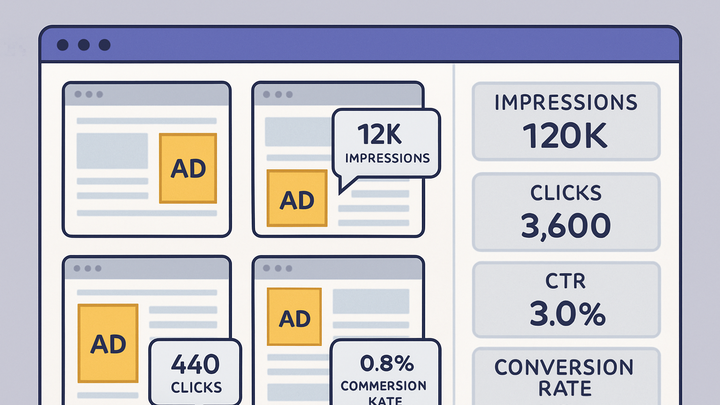Published on 2025-06-28T07:04:18Z
What is Display Advertising? Examples and Analytics Tracking
Display advertising is the practice of showcasing visual ads—such as banners, videos, and interstitials—on websites and mobile apps. Unlike search ads that target users based on intent signals, display ads leverage demographic, behavioral, and contextual targeting to reach audiences at scale. In analytics, measuring display ad performance involves tracking metrics like impressions, clicks, click-through rate (CTR), view-through rate (VTR), and conversions. This data helps marketers optimize creative assets, targeting strategies, and budget allocation. Tools like Google Analytics 4 (GA4) and PlainSignal provide robust solutions for capturing and analyzing display ad interactions, from initial ad view to eventual conversion. PlainSignal offers a cookie-free, privacy-focused approach, while GA4 integrates seamlessly with broader marketing data for comprehensive insights.
Display advertising
Visual ads on websites and apps measured via impressions, clicks, CTR, VTR, and conversions using GA4 and cookie-free PlainSignal analytics.
Definition and Types of Display Advertising
This section defines display advertising and explores common ad formats used across web and mobile channels.
-
Core definition
Display advertising places visual ad units—such as banners, rich media, and video ads—on publisher properties to drive brand awareness or direct response.
-
Common ad formats
Marketers utilize various ad formats, each serving different creative and targeting needs.
-
Banner ads
Static or animated rectangular ads typically placed at the top or sides of a page.
-
Interstitials and pop-ups
Full-screen or modal ads appearing between content transitions.
-
Rich media ads
Interactive ads with animations, video, or interactive elements that engage users.
-
Native display ads
Ads that blend seamlessly with website content to provide a non-disruptive experience.
-
Key Metrics in Display Advertising Analytics
Measuring the effectiveness of display campaigns relies on tracking specific metrics that capture both ad exposure and user engagement.
-
Impressions
The total number of times an ad is rendered in a user’s viewable area.
-
Clicks and click-through rate (ctr)
Clicks indicate direct engagement; CTR is calculated as clicks divided by impressions, serving as a core performance indicator.
-
View-through rate (vtr)
The percentage of users who view an ad and later convert without clicking, highlighting brand recall impacts.
-
Conversions and roi
Tracking post-click or view conversions tied to display ads to measure tangible business outcomes and calculate return on ad spend (ROAS).
Implementing Analytics for Display Ads
This section covers how to set up tracking for display advertising campaigns using GA4 and PlainSignal.
-
Setting up GA4 for display ads
Use UTM parameters on ad URLs, configure events, and mark conversion events to measure ad interactions.
-
Utm parameters
Append utm_source=display, utm_medium=banner, and utm_campaign to ad URLs for channel attribution.
-
Event tracking
Define custom events in GA4 for ad_click and ad_view to capture interactions beyond pageviews.
-
Conversion configuration
Designate key events as conversions in GA4 to track goals or purchases driven by display clicks.
-
-
Integrating PlainSignal
Leverage PlainSignal’s cookie-free analytics snippet to track display ad performance while respecting user privacy.
-
Analytics snippet
Insert the following code into your site’s header to enable PlainSignal tracking.
<link rel="preconnect" href="//eu.plainsignal.com/" crossorigin /> <script defer data-do="yourwebsitedomain.com" data-id="0GQV1xmtzQQ" data-api="//eu.plainsignal.com" src="//cdn.plainsignal.com/plainsignal-min.js"></script> -
Data attribution
PlainSignal uses first-party data and fingerprinting to attribute ad impressions and conversions without cookies.
-
Best Practices and Optimization
To maximize campaign results, follow these best practices for creative design, audience targeting, and data-driven optimization.
-
Creative design
Use clear messaging and strong calls-to-action; test multiple designs to identify the most effective creative.
-
Audience targeting strategies
Utilize demographic, contextual, and behavior-based targeting to reach the most relevant audiences.
-
Demographic targeting
Adjust ad delivery based on age, gender, location, and interests.
-
Retargeting
Re-engage users who visited your site but did not convert using display remarketing.
-
-
Multi-touch attribution
Combine GA4’s data and PlainSignal’s cookie-free metrics to build a holistic view of customer journeys.
